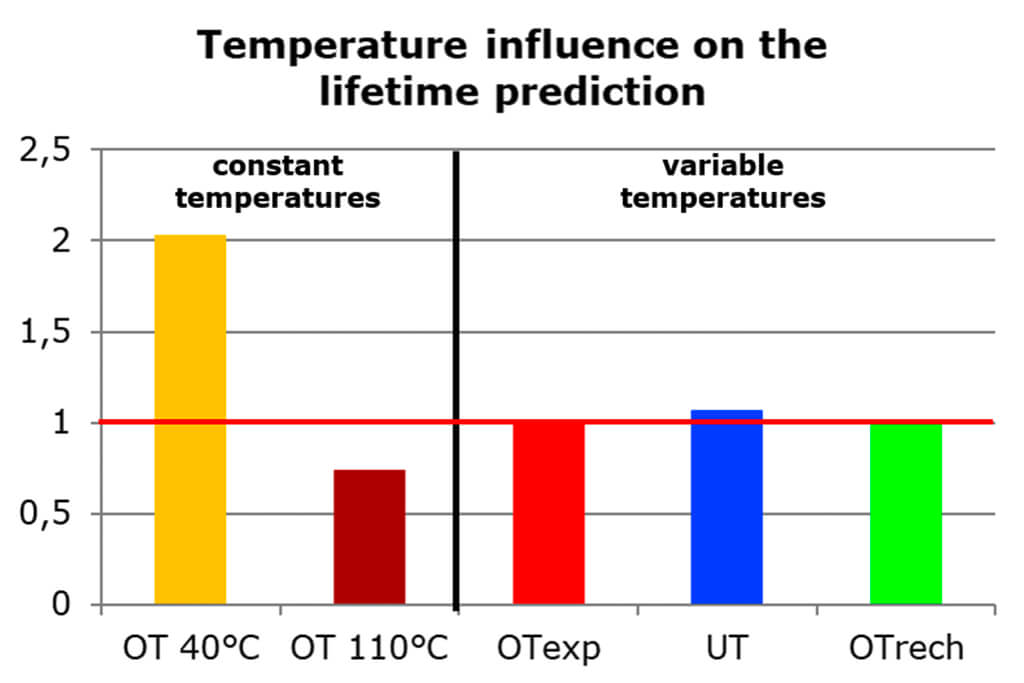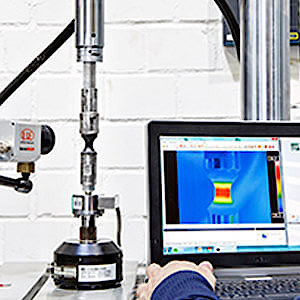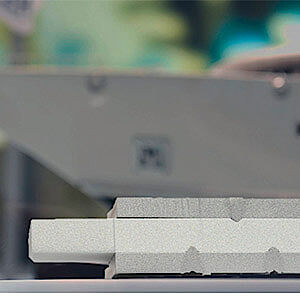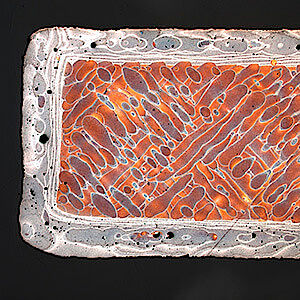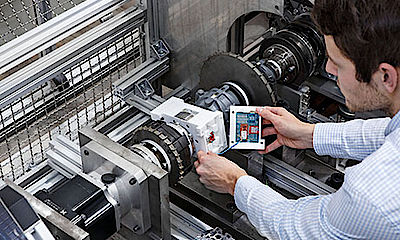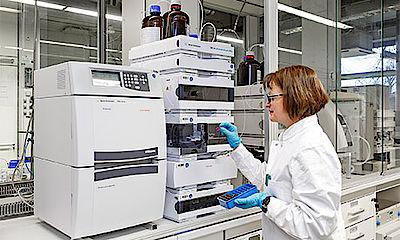Temperature-dependent lifetime prediction for elastomer components.
ELASTOMERS, LIFECYCLE CALCULATION, COMPONENT INSPECTION, CONCEPT DEVELOPMENT
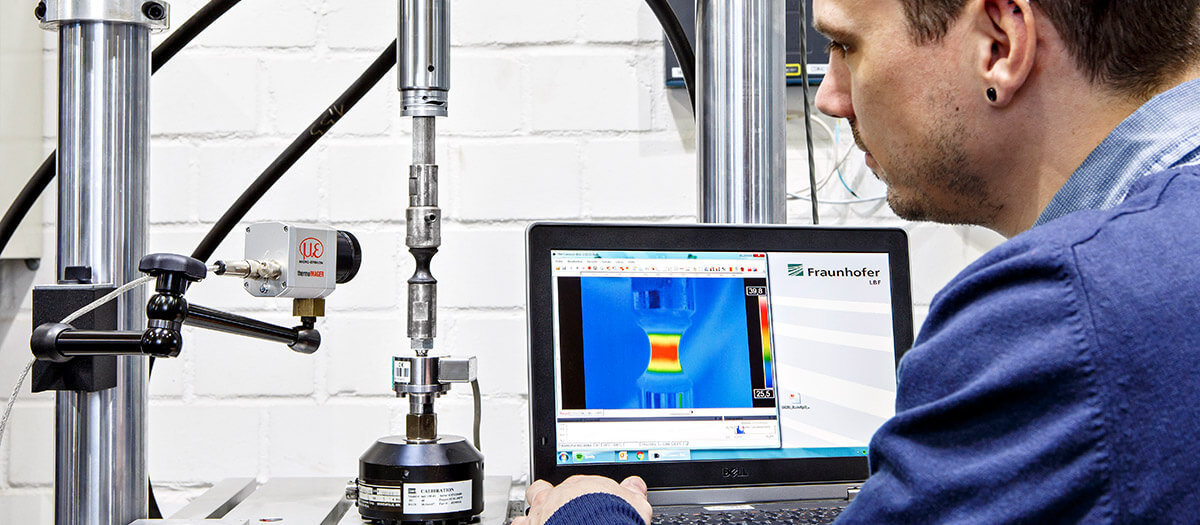
Elastomers are used in many different application areas, primarily for damping vibrations. Their operating temperature is generally between -50 °C and 150 °C. However, during operation the temperature development depends not only on the ambient temperature, but also to a significant extent on self-heating due to the dissipated energy under cyclical load. The dissipated energy is decisively affected by the material properties. The increases in temperature impact the mechanical behavior and thus the lifetime, and for this reason should be taken into account in the design process. The AiF projects ”Elasto-Opt I and II” were implemented in a partnership between the Technische Universität Darmstadt, Bundeswehr University Munich and Fraunhofer LBF. They focus on capturing and accounting for this temperature dependency in FEM simulation and methods of lifetime analysis. The result is a concept for temperature-dependent lifetime prognosis of elastomer components that is ready for use in applications.
Natural rubber and its performance under temperature exposure
The projects involved experimenting on a total of three elastomer compounds based on natural rubber (NR) with hardnesses of 43, 60 and 68 on the Shore A scale to determine their properties and their lifetime behavior under the influence of temperature. These experiments showed that important material properties like viscoelasticity in the form of relaxation behavior are highly dependent on the material temperature. In terms of the lifetime, it was also possible to identify a clear temperature dependency in particular during component testing. Furthermore, the material testing confirmed that there is a significant difference in the material behavior of elastomers with the same NR basis but different compounds. For the three elastomer compounds, major differences were identified in the extent of the Mullins effect, stiffness and hysteresis area, which plays a decisive role in determining the damping. These differences are connected to the Shore A hardness level, which is mainly adjusted according to the carbon black content. This also causes significant differences with regard to the self-heating. For elastomer compounds with low damping, test specimen temperatures of approx. 40 °C on the surface were measured under cyclical loading, whereas temperatures of up to 55 °C were measured at the compound with high damping under same loading conditions.
New concept for the temperature-dependent lifecycle prognosis of elastomer components
The first cornerstone, for taking into account the temperature in the component design process, was laid in the project Elato-Opt I as a collaboration between the Technische Universität Darmstadt and the Fraunhofer LBF. The prototype of a concept approach for temperature-dependent lifetime analysis was presented. In the subsequent Elasto-Opt II project, this concept was further developed and made ready for use in applications, and subsequently validated with test results.
The special feature of the new concept is the automated inclusion of variable temperatures in the linear cumulative damage. In contrast to the ”worst-case” prognoses commonly used in practice that merely apply constant temperatures, this concept is able to predict the component lifetime more realistic regarding the temperature influences.
An important component of this concept is the material model of finite thermoviscoelasticity, developed by project partner the Bundeswehr University Munich, for use in the FEM simulation. This material model can calculate the self-heating of elastomers and is incorporated into the newly developed method for analytical estimation of component temperatures. This method enables load-time histories of a typical length under operational loads to be processed in a computationally efficient way, while the temperature development on the surface is estimated analytically. In the Elasto-Opt II project, this method could be used to estimate surface temperatures of component tests performed under variable ambient temperatures.
Ultimately, the integration of calculated or experimental variable temperature histories into the lifetime prognosis led to a significant improvement in the results. In Fig. 1 are shown the deviations of the calculated lifetimes with constant (yellow, dark red) and variable temperatures (blue, green) relative to the experiment. These results show that the constant temperatures over- or underestimate the lifetime as expected, whereas the inclusion of realistic temperature histories leads to a very good prediction.
Customer benefits
The developed concept makes a significant contribution to improving the design process of elastomer components regarding temperature influences. This improvement enables customers to design the components in a more targeted way for the relevant application, in order to improve component reliability and ultimately to spare resources.
The IGF-project 18917N by the Forschungsvereinigung Forschungskuratorium Maschinenbau e.V. (FKM) was funded via the AiF as part of the program on funding collective industrial research (IGF) by the Federal Ministry for Economic Affairs and Energy following a decision of the German Bundestag.




“Good lifetime prognoses are only achieved when the most relevant factors influencing the lifetime during operation are considered. Elastomer components are often subjected to high temperatures during operation, such as in the engine compartment. The concept that has been presented can be used to predict the lifetime with higher accuracy by taking the temperature into account in the design process.” Gabriela Parra Pelaez, M. Sc.
Contact
- Riccardo Möller
- Phone: +49 6151 705-408
- riccardo.moeller@lbf.fraunhofer.de
- Gabriela Parra Pelaez
- Phone: +49 6151 705-623
- pelaez@sam.tu-darmstadt.de
